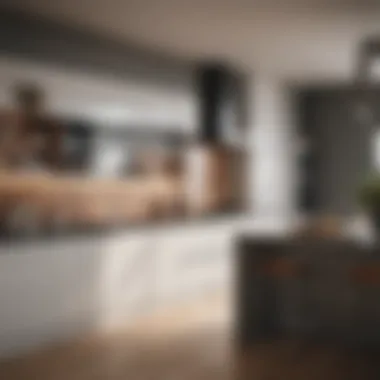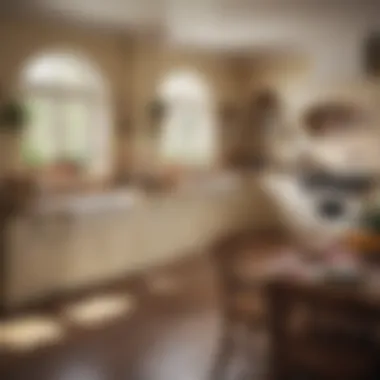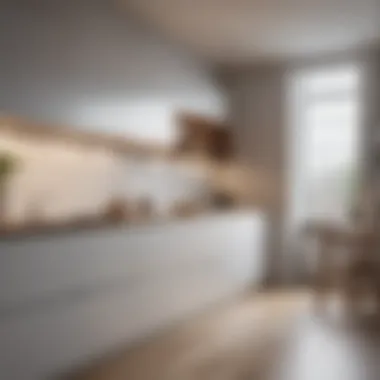Discovering Kitchen Styles: A Detailed Guide


Intro
The kitchen is more than just a place to cook. It often serves as the heartbeat of the home, where families gather, meals are shared, and memories are made. As such, the style of a kitchen plays a crucial role in not only the functionality of the space but also the overall aesthetic of the home. This exploration into different kitchen styles unravels how individual preferences, cultural influences, and practical needs shape kitchen design today.
From the sleek, no-nonsense lines of modern kitchens to the warm, inviting feel of rustic spaces, every style tells a story. Homeowners and design enthusiasts alike can benefit from understanding these various styles; after all, choosing the right kitchen can enhance both the beauty and efficiency of a home. Understanding these differences also helps in making informed decisions on renovations or new builds.
This guide will traverse the landscape of kitchen styles, demonstrating how design elements intertwine with functionality. By examining modern, minimalist, industrial, and more traditional styles, this article aims to equip readers with insightful knowledge necessary to tailor a kitchen space to their personal taste and lifestyle needs.
Furniture Design Trends
Current Styles and Aesthetics
Current furniture design trends in kitchens reflect a seamless blend of aesthetics and functionality. Kitchens today often feature multi-purpose furniture that works hard—think tables that double as prep areas, and islands that incorporate seating for casual meals.
- Modern Minimalism: Characterized by clean lines and a lack of clutter, modern minimalism is perfect for those who appreciate simplicity. Flat-front cabinetry and hidden appliances create a streamlined look.
- Rustic Charm: With elements like reclaimed wood and farmhouse-style cabinetry, rustic kitchens evoke warmth and nostalgia. This style might include vintage hardware and open shelving displaying artisanal pottery.
- Industrial Edge: Exposed brick walls and metal accents define industrial kitchens. Here, unfinished surfaces bring a raw, urban vibe, perfect for those who enjoy an eclectic mix of styles.
- Traditional Elegance: Classic designs feature ornate cabinetry and warm, welcoming colors. Traditional kitchens often include decorative moldings and vintage-style appliances.
Color Palettes and Materials
Selecting the right colors and materials is key in defining any kitchen style. Popular choices include neutral shades of gray, navy blue, and earthy greens that can create calming environments, while vibrant accents like rich reds or sunny yellows can embolden the aesthetic.
Materials also play a vital role:
- Quartz and Granite: Ideal for countertops, both materials provide durability and a range of colors.
- Wood: Often used for cabinetry, wood adds warmth and a touch of nature.
- Stainless Steel: This material fits well in modern and industrial kitchens alike, offering a sleek and professional appearance.
"A well-designed kitchen is not just about aesthetics; it’s about how it functions and feels over time."
Buying Guides
Essential Considerations When Purchasing
When it comes to customizing a kitchen space, there are several key considerations:
- Space Planning: Understanding the flow of the kitchen is essential to ensure efficiency. Consider traffic patterns and how different areas will be used – cooking, cleaning, and storage.
- Budget: Set a realistic budget and think about the long-term value of your investments.
- Style Cohesion: It’s important that the kitchen style aligns with the overall design of the home.
Top Recommendations for Different Budgets
Regardless of budget, there are options for every homeowner:
- Low Budget: Consider DIY projects like repainting existing cabinetry or adding new hardware for an instant facelift.
- Mid Budget: Explore semi-custom cabinetry or opt for laminate countertops that mimic high-end materials.
- High Budget: Invest in custom cabinetry and premium appliances. Luxurious materials like marble can be game-changers.
Understanding these elements provides homeowners with the tools to making the right choices, bringing their dream kitchens to life.
Understanding Kitchen Styles
When diving into the world of kitchen design, understanding various kitchen styles is akin to striking gold. The kitchen isn’t just a functional area; it serves as the heart and soul of a home. This article aims to illustrate the significance of kitchen styles, spotlighting their unique features, benefits, and the subtle considerations that come into play during the design process.
The Importance of Kitchen Design
Kitchen design plays a pivotal role in shaping the overall environment of a house. A well-designed kitchen optimizes space, invites social interaction, and enhances the cooking experience. Consider how a cramped, cluttered kitchen could feel like being trapped in a sardine can. In contrast, an open layout filled with light and air can energize and uplift the everyday task of meal prep.
Moreover, a thoughtfully designed kitchen aligns with your lifestyle and personal habits. For example, if you regularly entertain, you might opt for a layout that promotes conversation, such as an island that serves as both a cooking space and a gathering spot. On the other hand, for those who prioritize efficiency, streamlined modern designs might be more appealing.
To sum up, kitchen design is not like pouring milk into cereal; it’s about mixing the right elements to create a nurturing space for family and friends. When you take the time to contemplate your kitchen style, you ensure it will be a fulfilling extension of your lifestyle.
Cultural Influences on Kitchen Styles
Cultural influences have always played a crucial role in shaping kitchen styles. Various regions boast distinctive design elements influenced by traditions, cooking practices, and available materials. For instance, the warm hues and intricate tile work often associated with Mediterranean kitchens create an inviting atmosphere, reflecting communal meals and festivities.
In stark contrast, Scandinavian kitchens embrace simplicity and functionality, showcasing light colors and clean lines, which mirror the region’s minimalist lifestyle. The connection between cultural identity and kitchen design cannot be overstated; it’s much like a painter choosing the colors for their masterpiece.
"The kitchen is not just a room; it’s a cultural canvas where functionality meets artistry."
Furthermore, as globalization fosters intercultural communication, kitchen design continues to evolve. Contemporary homeowners might find themselves blending styles, such as infusing rustic charm with modern convenience, creating a unique culinary haven that echoes diverse influences.
Understanding these cultural nuances is essential for homeowners, designers, and DIY enthusiasts alike. It doesn’t just help in making a design choice; it enables a deeper appreciation for the stories kitchens tell across different cultures. In examining these styles, you embark on a journey through culinary history, where every design choice holds significance.
Modern Kitchen Designs
Modern kitchens are at the forefront of contemporary home design. This section aims to illuminate the essential aspects of modern kitchen designs, emphasizing their sleek aesthetics and functional prowess. By understanding the unique elements that define modern kitchens, homeowners can make informed decisions that elevate both style and usability in their culinary spaces.


Key Characteristics of Modern Kitchens
Modern kitchens feature clean lines and a sense of openness that invites light and air. The emphasis is on simplicity and efficiency, with an inclination towards open floor plans that seamlessly connect the kitchen to living areas. Generally, they favor streamlined cabinetry, stainless steel appliances, and open shelving, which all contribute to a minimalist vibe.
"A modern kitchen is not just a place to cook; it’s a hub of social activity and an expression of personal style."
Another defining trait is multifunctionality. Modern kitchens often incorporate islands that can serve as cooking spaces, dining areas, or casual hangouts. The color palette tends to be neutral with splashes of bold colors provided by accessories or artwork, ensuring a balanced yet dynamic environment.
Color Schemes and Materials
When it comes to color schemes, modern kitchens often embrace muted tones, such as whites, grays, and soft earth tones. These hues create a calming backdrop, allowing the kitchen's functional elements to shine. However, one does not have to shy away from utilizing accents of vibrant colors through bar stools, art pieces, or decorative items to break the monotony.
The materials typically used are durable and easy to maintain. Think quartz or granite countertops, which not only provide a luxurious finish but also stand the test of time. Likewise, cabinetry in lacquered finishes or natural wood can add a touch of warmth while maintaining that modern flair.
Innovations in Modern Kitchen Technology
Technological advancements continue to revolutionize the way we design and operate kitchens. Smart appliances are leading the charge, with items such as refrigerators that can suggest recipes based on available ingredients or ovens you can control from your smartphone.
Additionally, advancements in cookware and energy-efficient appliances contribute to a sustainable environment while also enhancing the culinary experience. For instance, induction cooktops not only cook food quickly but also provide a safer cooking method.
In summary, modern kitchen designs encapsulate more than just aesthetic appeal. They embody a lifestyle where practicality meets style, making them a worthy consideration for any homeowner or design enthusiast.
Traditional Kitchen Styles
Traditional kitchen styles hold an esteemed place in the realm of home design. They evoke a sense of nostalgia and warmth, drawing upon classic design principles and furnishings that tell a story. The heart of a traditional kitchen lies not only in its aesthetics but also in its ability to create a comforting environment, where families gather and memories are made. This style harmonizes form and function, making it a popular choice among homeowners, designers, and DIY enthusiasts who treasure character over trend.
The importance of traditional kitchen styles in this article cannot be underestimated. They embody the essence of craftsmanship, often showcasing labor-intensive details that might be overlooked in modern design. For example, intricate cabinetry and rich wood tones are common elements that resonate with history and family connection. Traditional kitchens invite a welcoming atmosphere, encouraging both culinary exploration and heartfelt gatherings.
Defining Features of Traditional Kitchens
Traditional kitchens are easily recognizable through their key features that set them apart from more contemporary designs. First off, cabinetry adorned with raised panels and decorative moldings is a staple. These elements mirror the craftsmanship of past decades, contrasting with the sleek lines found in modern kitchens. Furthermore, an emphasis on symmetry enhances visual appeal—think of a center island flanked by evenly spaced stools.
In addition to cabinetry, the use of ornate hardware—brass knobs or antique-finish hinges—adds a touch of elegance. The color palette often revolves around warm, earthy hues like deep reds, greens, and warm neutrals, reinforcing a sense of coziness.
"Traditional kitchens tell a story of comfort and culture, imbuing spaces with warmth and a sense of home."
Popular Materials and Finishes
When considering materials and finishes for traditional kitchens, choices often reflect a commitment to durability and timeless appeal. Wood generally takes center stage, with options like oak, cherry, and maple widely used for both cabinetry and accents. The richness of natural wood allows it to age beautifully, gaining character over time.
Countertops are usually crafted from materials that blend function with aesthetic value. Granite and marble are frequently favored for their robustness as well as their classic looks. Meanwhile, ceramic tiles can be found on backsplashes, bringing in intricate patterns and colors that enhance the kitchen's overall character. To wrap it up, finishes typically range from matte to semi-gloss, ensuring surfaces are both appealing and easy to maintain.
Creating a Warm Atmosphere
One of the primary goals of a traditional kitchen design is to cultivate an inviting atmosphere. This can be achieved through careful layout and thoughtful decor choices. A good starting point is to maximize natural light by introducing large windows or French doors, allowing sunshine to illuminate the space.
Additionally, incorporating various lighting sources helps to create layered illumination. Consider pendant lights over an island paired with under-cabinet lighting. Such combinations not only enhance functionality but also invite warmth during evening moments when family and friends gather.
Another factor contributing to a warm ambiance is the presence of personal items or heirlooms—ceramic dishes, vintage canisters, or even framed family recipes hung on the wall. These touches are what truly make a kitchen feel like home.
In summary, traditional kitchen styles bring together enduring design elements, authentic materials, and heartfelt atmospheres. This blend of features resonates with those seeking to create spaces that reflect both their personal stories and a broader cultural heritage.
Minimalist Kitchen Aesthetics
Minimalist kitchen aesthetics have gained notable traction in recent years, appealing to homeowners and designers alike who crave a clean, uncluttered look that promotes both style and functionality. This approach to kitchen design emphasizes simplicity and intentionality, aligning perfectly with modern lifestyles where efficiency and peace of mind are paramount. The importance of minimalist kitchen aesthetics lies not just in their visual appeal but also in their capacity to elevate the overall cooking and dining experience while maximizing the use of space.
Core Principles of Minimalism
At its core, minimalism revolves around the idea of "less is more." In the kitchen context, this means prioritizing essential elements and eliminating unnecessary adornments. A few key principles include:
- Simplicity: Clean lines and geometric shapes prevail, with an absence of excessive details.
- Neutral Color Palette: Whites, grays, and earth tones dominate, creating a soothing backdrop that calms the mind.
- Functional Design: Every piece must serve a purpose; from storage solutions to appliances, everything should fit seamlessly into the overall design.
By adhering to these principles, a minimalist kitchen not only looks appealing but also functions effectively, offering ease of movement and a sense of liberation.
Functionality Meets Simplicity
In a minimalist kitchen, functionality dances harmoniously with simplicity. This means that while aesthetics are vital, the practicality of each element is equally important. For example, integrated appliances help create a cohesive look, as they blend into cabinetry rather than standing out. Open shelving can be both a stylish feature and a functional choice, allowing for easy access to commonly used items while promoting an open feel. This functionality fosters a productive cooking environment, free from distraction and clutter.
"The essence of minimalism is to strip down to what is absolutely essential, creating a space where every item holds value and serves a purpose."


Tips for Achieving a Minimalist Look
- Declutter Ruthlessly: Start by removing everything that doesn't have a distinct purpose in your kitchen. Keep surfaces clean and clear to create visual space.
- Choose Multi-functional Pieces: Invest in items that can perform multiple roles, like a kitchen island that offers both prep space and storage.
- Opt for Streamlined Cabinetry: Flat-panel cabinets devoid of ornate handles can reinforce the minimalist aesthetic.
- Limit Color Variation: Stick to a limited color scheme to maintain visual continuity. Too many colors can disrupt the sense of calm in the space.
- Incorporate Natural Elements: A few green plants or wooden accents can add warmth and life without cluttering the overall aesthetic.
By considering these elements, homeowners and designers can create a kitchen that looks polished and operates smoothly—an inviting yet efficient space that embodies the best of minimalist philosophy.
Rustic Kitchen Styles
Rustic kitchen styles have carved a niche in the realm of interior design, weaving in warmth and charm that resonate with both nostalgia and comfort. These kitchens often evoke a connection to nature, reflecting a simpler way of life that many homeowners yearn for in today's fast-paced world. By examining the elements, materials, and overall atmosphere, this section will shine a light on what makes rustic kitchens an enduring choice, highlighting their numerous benefits and thoughtful considerations.
Elements of Rustic Design
At the heart of rustic kitchens lies raw beauty and authenticity. Key elements often include:
- Natural Wood: Exposed beams, reclaimed wood cabinetry, and sturdy furniture showcase the character and history of the materials used.
- Stonework: Stone countertops and backsplashes serve as timeless features that add depth and texture, harmonizing with the organic theme.
- Warm Colors: Earthy tones, such as deep browns, warm grays, and muted greens, create an inviting atmosphere, often complemented by soft lighting.
These aspects not only create a visually appealing space but also infuse a sense of tranquility, where meal preparation and family gatherings feel like cherished moments rather than mere tasks.
Incorporating Natural Materials
In rustic kitchens, the use of natural materials can transform a standard space into something extraordinary. Integrating elements like:
- Bamboo or Cork Flooring: These options provide durability while maintaining an eco-friendly edge.
- Granite or soapstone: Perfect for countertops, these materials present beautiful patterns and textures that tell a story of their own.
- Woven Textiles: Adding fabrics like burlap or linen can soften the look without overpowering the rugged charm.
Utilizing these materials brings fresh life into the kitchen and underscores a commitment to sustainability, resonating well in an era where eco-consciousness is celebrated.
Creating Cozy and Inviting Spaces
To achieve a cozy atmosphere in a rustic kitchen, consider the following tips:
- Open Shelving: Displaying dishes and rustic pottery fosters a homey feel, inviting interaction rather than formality.
- Multifunctional Elements: Choose furniture that serves various purposes, such as a kitchen island with seating to encourage gathering and communal cooking.
- Personal Touches: Integrate family heirlooms or locally sourced decorations to enhance authenticity and a sense of belonging.
A rustic kitchen should feel like a warm embrace—a space where memories are made and stories are shared. When curated thoughtfully, these elements come together to create a heartwarming environment that goes beyond mere aesthetics.
"Rustic kitchens invite us to slow down, enjoy the simple pleasures, and make every meal an occasion."
In summary, rustic kitchen styles are more than just a design choice; they encapsulate a way of living, emphasizing comfort, connection, and a return to nature. By thoughtfully incorporating elements, embracing natural materials, and creating inviting spaces, homeowners can craft a kitchen that truly feels like home.
Industrial Kitchen Trends
Industrial kitchens are not just a style; they reflect a lifestyle that appreciates both the aesthetics of raw materials and the utility of function. This article examines the trends in industrial kitchens, which integrate the practical needs of cooking with a design philosophy that celebrates imperfections. Here we explore why industrial kitchen trends matter, particularly for homeowners, designers, and DIY enthusiasts who want to embrace this unique style.
Defining Characteristics of Industrial Kitchens
When one thinks of an industrial kitchen, several defining characteristics immediately come to mind. The first is the open layout, which creates a spacious and airy atmosphere. Instead of closed-off areas, industrial kitchens often feature an open design that encourages social interaction.
Next up are the materials used. Think steel, concrete, and reclaimed wood. They give the kitchen a rugged appearance reminiscent of old factories and warehouses. In addition to that, the color schemes are typically neutral, leaning towards grays, blacks, and whites, which can easily be matched with other decor elements.
Lastly, another noteworthy characteristic is the emphasis on utilitarian features. Open shelving instead of cabinets, exposed piping, and visible light bulbs create an unfinished look that many find appealing.
Exposed Elements and Raw Finishes
Exposed elements are a hallmark of industrial design. The beauty of an industrial kitchen lies in its raw finishes. Here, the materials tell their own story. For instance, exposed pipes and ductwork add a unique flair, and they evoke a sense of authenticity. They’re not merely elements of design but serve a purpose, enhancing both the function and style of your space.
Moreover, bare concrete countertops and unfinished cabinetry can practically give the kitchen a workshop-like feel. A key benefit of these raw materials is durability. They withstand wear and tear better than their polished counterparts, making them excellent for high-traffic areas where cooking is often done.
A well-known quote in design circles is:
"Style is a reflection of your attitude and your personality."
In industrial kitchens, this rings true. The exposed elements add a boldness that speaks to a homeowner’s love for genuine aesthetics.
Balancing Functionality with Style
Creating an industrial kitchen involves a fine balance between function and style. This balance is crucial as it can greatly affect the usability of the kitchen. For instance, incorporating well-designed kitchen islands with ample storage options can be both practical and stylish. They create a central hub for cooking and gathering, all while contributing to the industrial aesthetic.
Another aspect to consider is the lighting. Pendant lights with an industrial finish—think matte black or brushed metal—can enhance the look while providing essential illumination. Choosing fixtures that align with the overall theme brings coherence to the design.
In a nutshell, a successful industrial kitchen combines these elements in a way that preserves the raw aesthetic while ensuring the space is user-friendly. This approach fosters an environment that not only looks good but also functions seamlessly for daily activities.
Contemporary Kitchen Innovations


Contemporary kitchen innovations are reshaping how we perceive cooking spaces, blending the lines between functionality and style in imaginative ways. Homeowners and designers alike are increasingly acknowledging that a kitchen is not just a place for preparing meals; it's a vital part of home life. Thus, kitchen design picks up on technology and sustainable practices that can grow with our needs and lifestyles.
Latest Trends in Kitchen Technology
The heart of contemporary kitchen design lies in technological advancements. Some of the latest trends showcase how integrated technology simplifies daily tasks.
- Smart Appliances: Innovations such as refrigerators that can track grocery inventories and ovens controlled by smartphones are breaking ground.
- Touchless Faucets: These installations not only promote cleanliness but also maximize convenience in food preparation.
- Voice-Activated Systems: Imagine asking your kitchen assistant to start a timer while your hands are messy—this trend is becoming a common sight.
These technologies not only cut down on the physical effort involved in meal preparation but also add a touch of modern sophistication. Integrating such gadgets can effectively elevate both the aesthetic and functionality of your kitchen.
Integrating Smart Homes with Kitchen Design
As homes evolve to incorporate smart technology, kitchens are often at the forefront of these changes. The ability to control kitchen devices via smartphone apps or voice commands makes meal prep less cumbersome and more enjoyable.
- Connectivity Between Devices: Sensors and networks can communicate to ensure appliances function harmoniously. For instance, your coffee maker can learn your schedule and brew a fresh pot just as you wake up.
- Energy Management: By using smart systems, homeowners can monitor energy usage of kitchen appliances. This not only helps in lowering utility bills but also contributes to eco-friendly living.
- Customized Experiences: Many smart systems allow personalization. Whether it’s adjusting the fridge’s temperature for specific items or programming a multi-cooker to prepare meals automatically, customization enhances the cooking experience.
In essence, integrating these smart systems into the kitchen transforms how spaces are utilized, establishing conveniences that were once mere fantasies.
Sustainable Kitchen Practices
Sustainability is no longer a buzzword but an essential element to consider in contemporary kitchen design. With greater awareness of environmental impacts, homeowners are prioritizing eco-friendly practices.
- Energy-Efficient Appliances: Investing in Energy Star-rated fixtures can lead to substantial energy savings, a practical choice for the environment and the wallet.
- Waste Reduction Strategies: Implementing composting systems and recycling bins in the kitchen encourages responsible waste management.
- Sustainable Materials: Choosing cabinetry, countertops, and flooring made from sustainable sources not only enhances the kitchen’s beauty but also supports responsible production methods.
By implementing sustainable practices, kitchens not only offer a modern touch but also actively participate in conservation efforts, aligning with a growing global responsibility.
The modern kitchen is evolving beyond its traditional role, becoming a cornerstone for innovation, technology, and sustainability.
In summary, contemporary kitchen innovations represent a pivotal shift in home design. As we continue to embrace smarter appliances and sustainable practices, the kitchen transforms into a space that is not only functional but also environmentally conscious. This steady integration of technology and earth-friendly approaches shapes the future of kitchen design, providing homeowners with exciting options to consider in their own homes.
Choosing the Right Style for Your Home
When it comes to creating a kitchen that feels just right, there's a lot that goes into the decision-making process. Choosing the right style for your home is crucial because the kitchen is often the heart of the household. It’s where meals are prepared, conversations happen, and memories are made. Selecting a style that resonates with your personal aesthetic, fits your lifestyle, and works harmoniously with your home environment can transform not just the look, but also the functionality of your cooking and gathering space.
Assessing Your Space and Lifestyle
Before diving into styles, it’s wise to evaluate your space and lifestyle. Start by measuring your kitchen area. Consider whether you have a wide open space, a cozy galley, or something in between. This will greatly influence style choices. For example, someone with a small kitchen might prefer a minimalist approach to maximize functionality, while someone with ample space can explore designs that offer room for creativity, like an industrial or rustic style.
Your day-to-day life should also guide your decisions. If you’re a culinary whiz, perhaps the modern style with its sophisticated appliances and clean lines suits you best, enabling efficiency and creativity. If your kitchen serves as a social hub for family gatherings, a warm, traditional design might be more fitting, creating an inviting atmosphere for those cherished get-togethers.
Harmonizing with Existing Design Elements
Next up is harmonizing with existing design elements. Think about how your potential kitchen style syncs with the rest of your home. Are your walls painted in bold colors or softer neutrals? Do you have a mix of modern and vintage furnishings? Ensuring that your kitchen reflects these elements will not only enhance the aesthetic appeal but create a consistent flow throughout your home.
For instance, if your home leans toward a modern aesthetic, adopting a contemporary kitchen style with integrated appliances and sleek cabinetry can maintain that flow. However, if you're looking to mix things up, a shabby chic or eclectic kitchen might work well alongside other styles, creating visual interest without feeling disjointed.
Budget Considerations
Lastly, it's essential to account for budget considerations. When deciding on a kitchen style, understanding what you’re willing to invest is critical. High-end designs, like those featuring custom cabinetry or advanced technology in appliances, can put a dent in your wallet. Conversely, styles such as rustic or farmhouse can often be achieved with upcycled materials, potentially saving costs while adding personality.
Create a budget outline that includes materials, labor costs, and potential hidden expenses like plumbing changes or electrical work. Make a list of must-have features against nice-to-have ones to guide you on what is feasible within your financial constraints.
"A clear understanding of your budget can lead to smarter choices and a happier kitchen environment."
By strategically considering your space, lifestyle, existing home design, and budget, you can successfully choose a kitchen style that complements and enhances your living experience.
The End: The Future of Kitchen Design
As we move into an era where our living environments continually adapt to our evolving needs, the future of kitchen design is not merely a topic of curiosity; it is a vital consideration for homeowners and designers alike. This article has navigated through different styles of kitchens, underscoring how thoughtful design can dramatically affect not just aesthetics but also the functionality of the heart of the home. Kitchen design is more than just creating a beautiful space; it is about enhancing the lifestyle of those who inhabit it.
Evolving Trends in Kitchen Styling
The kitchen is transforming faster than a batch of sourdough bread rising on a sunny windowsill. Trends in kitchen styling are evolving at astonishing speeds. Designers are moving towards spaces that reflect personal stories, unique tastes, and practical sensibilities.
- Homeowners are increasingly interested in open-concept designs. This creates a flow between the kitchen and living areas, making the entire space feel more inclusive.
- The rise of multifunctional spaces can’t be ignored. People are often using their kitchens for more than just cooking; they are spaces for social gatherings, homework, and even remote work. Consequently, there's a push for islands with attached tables and seating arrangements that turn kitchens into gathering hubs.
- Technology, too, plays a pivotal role. Smart devices and appliances are no longer a luxury; they are becoming essential elements in a modern kitchen. Homeowners appreciate added convenience and efficiency, from smart fridges that can suggest recipes based on what's inside, to ovens you can control with just a voice command.
Sustainability and Functionality as Driving Forces
In recent years, the conversation around sustainability has shifted from the margins to the forefront of kitchen design. Homeowners are becoming more aware of their impact on the environment. A kitchen that combines sustainability with functionality is increasingly sought after.
- Material choices matter. Eco-friendly materials like reclaimed wood or recycled glass are becoming the norm, not the exception. Homeowners are leaning towards brands that prioritize sustainability without skimping on style.
- Energy-efficient appliances are no longer a rarity, but an expectation. With consumer awareness growing, the demand for products that conserve both energy and water is higher than ever.
- Additionally, the integration of indoor gardens or herb planters is an innovative way to fuse functionality with sustainability. This concept offers not just a design element, but also provides fresh ingredients at arm's length, promoting healthy living and cooking.
As kitchens evolve, they reflect our values and lifestyles, and the traditional views of what a kitchen should be are being reshaped.
In the broad spectrum of kitchen styles explored in this article, the future points towards spaces that are deeply personal, environmentally conscious, and technologically advanced. Understanding these trends can help homeowners and designers make informed decisions, ensuring that their kitchens are not just a place to cook but an integral part of their lives for years to come.















